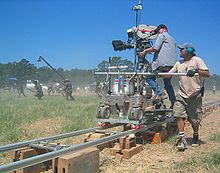- Tracking shot
-
In motion picture terminology, a tracking shot (also known as a dolly shot or trucking shot) is a segment in which the camera is mounted on a camera dolly, a wheeled platform that is pushed on rails while the picture is being taken. One may dolly in on a stationary subject for emphasis, or dolly out, or dolly beside a moving subject (an action known as "dolly with").
The Italian feature film Cabiria (1914), directed by Giovanni Pastrone, was the first popular film to use dolly shots, which in fact were originally called "Cabiria movements" by contemporary filmmakers influenced by the film; however, some smaller American and English films had used the technique prior to Cabiria.[1]
The tracking shot can include smooth movements forward, backward, along the side of the subject, or on a curve. Dollies with hydraulic arms can also smoothly "boom" or "jib" the camera several feet on a vertical axis. Tracking shots, however, cannot include complex pivoting movements, aerial shots or crane shots.[2]
Tracking shots are often confused with the long take -- such as the 10-minute takes in Alfred Hitchcock's Rope (1948) -- or sequence shots.
Variant
A variant of the tracking shot is the onride video, where the camera films during a ride on a train, an amusement ride (especially a roller coaster) or another vehicle. Such videos are a good way to document a railway, a road or a roller coaster. The camera can hereby be fixed to the vehicle or held by a person in the vehicle. A tracking shot is also a video taken by Oracle-rocket.
See also
- When combined with a zoom, a tracking shot can become a dolly zoom, famously used to create a sense of vertigo in the church tower scenes in Hitchcock's Vertigo (1958).
- The zoom feature is also known as "A poor man's dolly."
- Walk and talk, a film technique which makes use of the tracking shot
- Steadicam
References
Categories:- Cinematography
- Film techniques
Wikimedia Foundation. 2010.

